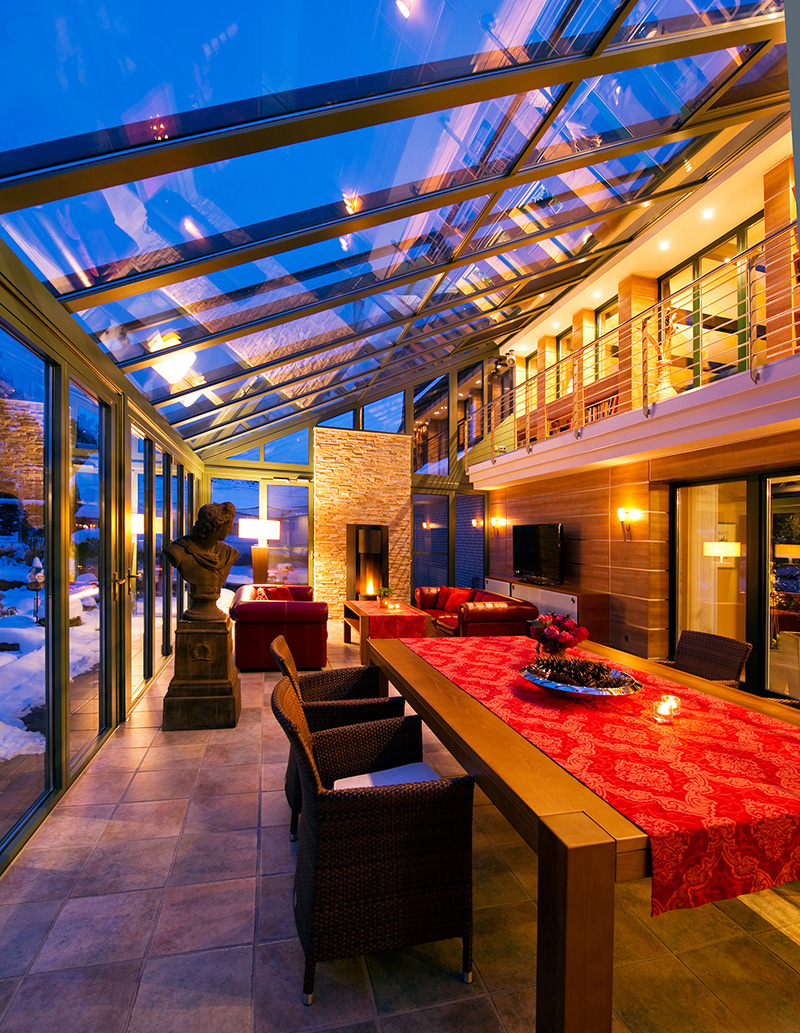Excellent insulation!
Being surrounded by nature every day, even when it’s still cold outside – a wintergarden is a wonderful addition to any home. But if you don’t have the right insulation, expensive energy bills will soon take the edge off that joy. Adding a bi-folding door as a partition between your wintergarden and the rest of your house can help to reduce heat loss without blocking your view of the outdoors.
As extensions to existing homes, wintergardens need to be able to withstand a lot, especially when the weather turns less clement. If you want to keep using your wintergarden as a cosy living room on cold days, heating is a must – and so is proper insulation to keep that heat in. It’s also a legal requirement, as energy saving regulations also apply to wintergardens, especially those used as living spaces all year round.
No “one size fits all” solutions
But what factors do you need to consider? What’s the best type of glazing to use? And what heating systems are suitable for this purpose? “That depends on the facade of the house, the wintergarden requirements, the local climate and, of course, the quality of the wintergarden,” says Stephan Hettlich. “There’s no ‘one size fits all’ solution.” Hettlich is in charge of the Solarlux Academy, where the north-west German wintergarden manufacturer trains its staff and dealership partners. His motto is: “Plan properly now and you won’t be frustrated, annoyed or disappointed later.” And such plans should always include input from a good heating engineer.
In order to ensure that a new wintergarden for a new build is in line with legal energy-saving requirements, triple glazing is recommended. For period buildings, which are subject to less stringent requirements in terms of energy conservation, double glazing is usually sufficient. Hettlich generally advises against using quadruple glazing in an attempt to achieve the best level of insulation possible. “The procurement costs are higher, but the system only offers minimal improvement in terms of energy efficiency. On top of that, this type of glazing is incredibly heavy, which limits your options when planning and building your wintergarden,” he explains.
Heating with the energy of the sun
Generally speaking, it is true that an insulated building facade is better for keeping the heat energy in the living space and an all-glass front. But that doesn’t mean that wintergarden owners are automatically worse off in this regard. The sun is the key here: it can heat the wintergarden in winter, thus reducing energy costs. This even works with scattered light when the sun is not shining onto the wintergarden directly. This solar heating effect also benefits the neighbouring rooms and can thus reduce heating costs on sunny days – even when the temperatures outside start to plummet.
However, if it is too cold and/or the sun’s energy alone is not enough to heat the wintergarden, an appropriate heating system is required. “When you’re not using your wintergarden, you can separate it from the rest of your living space using a bi-folding door,” Hettlich says. “This is a great option for anyone who wants to get the most out of their insulation,” he adds. A Solarlux bi-folding door is the perfect choice for this task – the glazed wall provides additional insulation without obstructing the view of the outdoors. On top of this, the glass elements can be folded away to the side to save space. This allows the wintergarden and the house to blend together to form one harmonious unit. Open or closed, this ensures that the living spaces always receive plenty of daylight.
